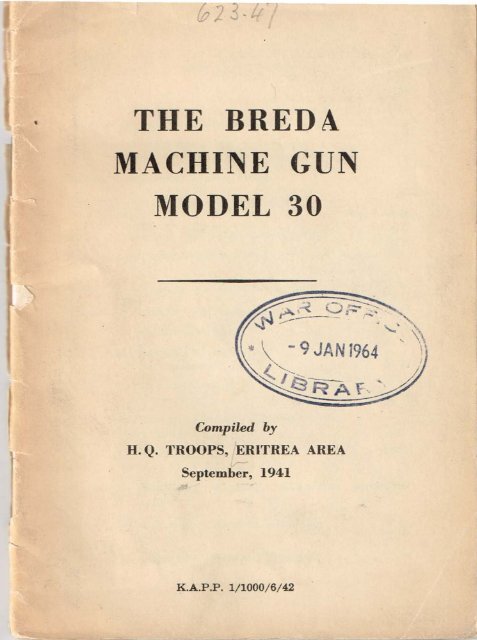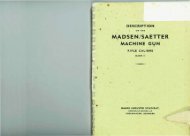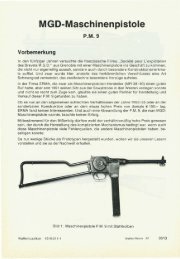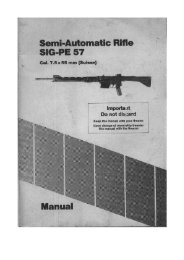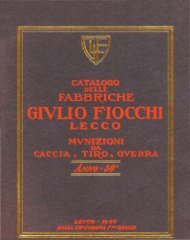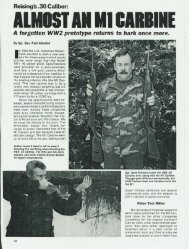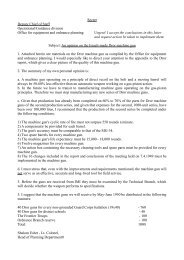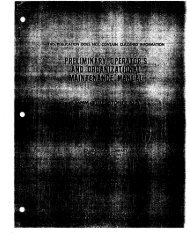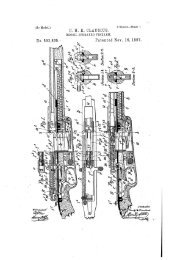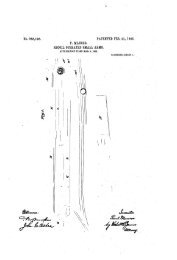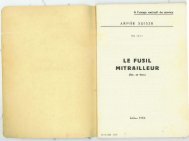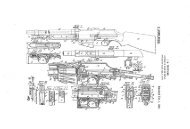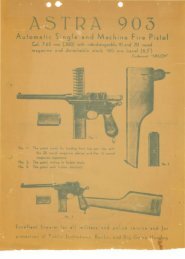Breda Model 30 manual.pdf - Forgotten Weapons
Breda Model 30 manual.pdf - Forgotten Weapons
Breda Model 30 manual.pdf - Forgotten Weapons
Create successful ePaper yourself
Turn your PDF publications into a flip-book with our unique Google optimized e-Paper software.
THE BREDA<br />
MACHINE GUN<br />
MODEL <strong>30</strong><br />
Compiled by<br />
H. Q. TROOPS, ERITREA AREA<br />
September, 1941<br />
K.A.P.P. 1/1000/ 6/42
•<br />
General Notes<br />
CONTENTS<br />
Detailed description for armourers use<br />
Contents of maintenance box<br />
Section 1.-Holding, Aiming, Firing.<br />
Lesson !.- Introduction and Loading the<br />
charger<br />
"<br />
2.- Loading, Unloading, Sightsetting<br />
3.- Holding, Aiming, Firing<br />
Page<br />
4<br />
5-13<br />
13-14<br />
14-15<br />
15-16<br />
16-17<br />
Section 2.-Stripping, Cleaning, Mechanism.<br />
Lesson 4.- Stripping and assembling<br />
17-18<br />
" 5.- Additional stripping<br />
19-20<br />
" 6.- Cleaning, lubrication and<br />
maintenance<br />
20-21<br />
" 7.- Care and cleaning - daily and<br />
before firing<br />
21-22<br />
8.- Care and cleaning - during intervals<br />
of firing . . . 22<br />
" 9.- Mechanism 22-24<br />
Section 3.-Elementary Handling, Stoppages, Immediate<br />
Action.<br />
Lesson 10.- Elementary Handling (The Gun<br />
Team)<br />
" H.- Immediate action and Stoppages<br />
·3<br />
25-27<br />
27-38
THE BREDA MACHINE GUN - MODEL 80<br />
GENERAL NOTES<br />
An air cooled, recoil operated weapon. Is fired shouldercontrolled<br />
from a bipod. To avoid overheating, strain, and<br />
excessive expenditure of ammuntion, bursts should be of<br />
5 or 6 rounds.<br />
To preserve the life of the barrel; it is advisable to change<br />
after every 200 rounds at rapid rate.<br />
Muzzle Velocity<br />
Calibre<br />
Barrel<br />
Rate of fire<br />
Length (over hall)<br />
Weight<br />
Method of loading<br />
Type of sights<br />
GENERAL DESCRIPTION<br />
The secret of success with this weapon is:<br />
2050' per second.<br />
6.5 mm. (.256").<br />
4 grooves, right hand turn.<br />
400 to 500 rounds per minute.<br />
48".<br />
21 lbs.<br />
Chargers of 20 rounds.<br />
Foresight - blade.<br />
Backsight - bed.<br />
A "V" sight.<br />
Graduated from <strong>30</strong>0 metres to<br />
1500 metres.<br />
There is no marking for 400<br />
metres.<br />
Fixed sight up to <strong>30</strong>0 metres.<br />
(As. the variation between metres<br />
and yards gives a discrepancy<br />
of 70+ at 750+ a deduction of<br />
50 from each range up to 750+<br />
will give a reasonably accurate<br />
elevation. Subsequent corrections<br />
, are made by observation of<br />
strike.)<br />
"KEEP IT CLEAN - KEEP IT LUBRICATED"<br />
4<br />
DETAILED DESCRIPTION OF THE PARTS<br />
(For use of Unit Armourers)<br />
PREDOMINATING FEATURES<br />
1. Protecting jacket (body extension).<br />
2. Foresight.<br />
3. Bracket for attachment of legs bipod.<br />
4. Recesses inside body.<br />
5. Interrupted threads for union of guard trigger and body.<br />
6. Lugs for fixing body cover.<br />
7. Fermeture nut.<br />
8. Guide fermeture nut (with locking wedge).<br />
9. Safety piston.<br />
10. Bed backsight.<br />
11. Lever retaining fermeture nut.<br />
12. Spring lever retaining fermeture nut.<br />
13. Guard trigg·er.<br />
14. Catch safety (hand).<br />
15. Trigger.<br />
16. Wings securing guard trigger to butt.<br />
17. Guide spring recoil.<br />
18. Pin firing release.<br />
19. Block breech.<br />
20. Spring recoil.<br />
21. Spring buffer.<br />
22. Spring pin firing.<br />
'23. Pin firing.<br />
24. Pump lubricating cartridges.<br />
25. Butt.<br />
26. Grip guard trigger.<br />
27. Strap butt.<br />
28. Legs bipod.<br />
29. Tubular catch fixing bipod legs.<br />
<strong>30</strong>. Recess for leg plunger. Open position.<br />
31. Recess for leg plunger. Closed position.<br />
32. Shoes.<br />
33. Rib of shoes.<br />
34. Barrel.<br />
5
The Body.<br />
At the front is an attachment for the union of the body<br />
extension, and at the rear nine interrupted threads in groups<br />
of three for the attachment of the guard trigger. Above are<br />
two lugs which serve as a joint for the combined cover-body<br />
with box lubricating. This cover-body closes the two apertures.<br />
The forward aperture forms the housing for the<br />
fermeture nut and contains two recesses for the engagement<br />
of the guide fermeture nut; in the rear of the aperture are<br />
two holes for the bolt fixing guide fermeture nut; this bolt<br />
is fitted with a catch and plunger to facilitate removal of the<br />
guide and a recess is formed on left side of body for correct<br />
engagement of the plunger.<br />
In the rear aperture of the body are formed two ribs; in<br />
the right hand rib is an orifice which enables lubricant from<br />
the spout of the lubricating box to pass through to the<br />
cartridges. At the rear is a housing which contains the<br />
safety piston and epring, also a screwed cap which, when<br />
fully screwed down, ensures that the point of the piston<br />
projects through the inside of the body; there is also a recess<br />
for the head of catch securing body cover.<br />
At the rear of the body is the maker's marking of the<br />
weapon; the bed backsight, and the catch, operated by twin<br />
ears which secures the body to the guard trigger. The box<br />
lubricating contains the lubricant, and on its rear face are two<br />
indentations to engage the plunger of the catch cover in either<br />
open "A" or closed "C" positions. (C-o = CHIUSO<br />
CLOSED - A = APERTO = OPEN). The upper surface is<br />
machined to break up the reflection of light and facilitate<br />
aiming. At the rear is the backsight of tangent aperture type<br />
graduated from <strong>30</strong>0 to 1,500 metres; is fitted with a slide,<br />
operated by a knurled head which transmits the movements<br />
through a pinion and rack. There is no marltlng for 400<br />
metres. A fixed "V" sight is provided which is equivalent to<br />
<strong>30</strong>0 metres.<br />
On the right of the body there is an aperture in which the<br />
magazine enters, and at the rear a housing for the ejector.<br />
A plate cover is fitted for retaining the feed block and ejector,<br />
this also acting as a recess for the engagement of the catch<br />
handle cocking when in the forward position. At the right<br />
rear are grooves for the reciprocating movement of the<br />
handle cocking, and three recesses which, when placed in<br />
alignment with similar studs on the handle, enable it to be<br />
removed from the body. There is also a recess for engaging<br />
6<br />
the hook of the handle when retaining the recoiling portions<br />
in the backward position.<br />
On the left is the ejection opening which may be closed<br />
by means of a cover fitted with catch and plunger, for securing<br />
in the open and closed positions; projecting into the<br />
interior of the body is an elongated solid projection which<br />
serves as a guide for the breech block.<br />
In the base are two elongated apertures which permit the<br />
access of the lever retaining nut fermeture. On the underside<br />
are grooves and housing for the cover lever fermeture nut<br />
and spring; the complete mechanism being protected by a<br />
cover being held in place by a spring and plunger.<br />
The Guard Trig·ger.<br />
Is rigidly connected to the butt and contains the trigger<br />
mechanism. On its upper inner surface are nine interrupted<br />
threads.for engagement with the body, a spring and plunger<br />
on the body, engaging in a recess in the guard trigger ensures<br />
that it is correctly and securely aligned. The guard is in two<br />
portions; the front, closed at rear by a sliding plate which<br />
carries a sprung retaining catch. The interior is traversed<br />
by the hand safety catch with catch and plunger; the plunger<br />
engages in suitable indentations marked . "F" (FIRE) which<br />
permits movement of the lever firing and "S" (SAFETY)<br />
which impedes the movement thus rendering the gun safe.<br />
The rear portion is rectangular, contains the lever firing<br />
mechanism and terminates in two wings for attachment to<br />
the butt. In the interior of the guard is a boss which serves<br />
as a guide for the guide-spring buffer; this has two apertures<br />
- the one in the centre of the boss being a passage for the<br />
tail of the pin firing, and the upper one a passage for the<br />
sear. Immediately in rear of head of boss is a recess for the<br />
operation of the pin firing release and its spring.<br />
The Banel.<br />
Is fitted at muzzle with an eliminator-flash and annular<br />
rings to . facilitate cooling, also a handle for removal and<br />
replacement. To the rear of the annular grooves are two<br />
longitudinal recesses for the engagement of the two projections<br />
on the catch barrel, thus securing the barrel to the body<br />
when the catch is closed. At the rear are two lugs; these<br />
when fitted into appropriate recesses in the fermeture nut,<br />
lock barrel and fermeture nut together. Between these two lugs<br />
and the first annular ring, stands a semi-circular projection.<br />
7
The Guide Spring Recoil.<br />
Is a hollow cylinder of two diameters. The interior of the<br />
larger diameter serves as a housing for the spring buffer,<br />
and the exterior for the spring recoil; the inside of the<br />
cylinder of smaller diameter serves as a passage for the pin<br />
firing and the front face forms a base for the spring pin<br />
firing.<br />
The Handle Cocking.<br />
Serves to draw back the recoiling portions by hand, has<br />
a projecting tooth for engaging the block breech, p.nd four<br />
recesses for its remove! from the body. On its exterior front<br />
is a claw which holds the handle in the forward position<br />
during firing, and at the rear is a levet· with senated face,<br />
bearing on its inner surface a hooked claw; this, when<br />
projected into the body retains the recolling portions in the<br />
backward position. To operate, the handle must be pulled<br />
back by hand, and the serrated lever forces inward against<br />
its spring; by releasing the handle the recoiling portions are<br />
now retained in the backward position by the hooked claw<br />
engaging in recess in body.<br />
To release pull back the cocking handle, and the recoiling<br />
portions are now held in checl< by the handle only.<br />
The Firing Mechanism.<br />
Consists of lever firing and trigger, pin fir"ing release, piston<br />
safety, pin firing and spring pin firing.<br />
The lever firing consists of the lever, the sear and the<br />
spring lever firing. When the trigger is pressed, the sear is<br />
forced forward and its inclined face depresses the pin firing<br />
release, thus releasing pin firing.<br />
The pin firing release operates in a recess in the boss of<br />
the guard trigger, and on its upper surface carries a recess<br />
in which the sear engages, on its lower surface is a position<br />
for its operating spring; in the centre is an aperture, chamfered<br />
on the front face to permit easy access by rear of pin<br />
firing, and sharp on rear face for the retention of the pin<br />
firing until the pin firing release is operated by the sear.<br />
The Safety Piston.<br />
Is situated on a platform in the body and operates in its<br />
appropriate aperture in the breech block. The interior is a<br />
hollow cylinder and its exterior base terminates in a tooth<br />
in the form of an inclined plane.<br />
10<br />
lm(JJ'Ortant.- When the piston is assembled to the gun, the<br />
beak or head of tooth must face the rear of the gun and<br />
project into the interior of body. The spring chamber must<br />
be uppermost and contains a spring whose function is to<br />
cause the beak of piston to protrude through the body. It is<br />
secured in position by a screwed cap, having in its centre an<br />
orifice for lubricating the piston.<br />
The tooth piston projecting through into the inside of the<br />
body, prevents the pin fidng going forward until the completion<br />
of the forward movement of the block breech; then,<br />
the piston is lifted by the ramp of the block breech; this does<br />
not take place until the breech is completely sealed.<br />
The firing pin consists of the point and the head with two<br />
teeth to engage the tooth of the safety piston, and the stem<br />
which terminates in a lug for engagement with the pin firing<br />
release.<br />
The spring firing pin is a coiled spring and uncompressed<br />
has a length of 7 and seven eighths inches.<br />
Components of Ejection.<br />
Consist of the ejector and the extractor. The ejector has<br />
an oval head and a catch oper·ated by a coiled spring. The<br />
projecting head of ejector, being opposite the head of<br />
extractor, causes the fired case to be ejected on the backward<br />
movement of the breech block.<br />
The extractor has a head for engaging the rim of the<br />
cartridge; a hole at the base for positioning, and a pivot and<br />
spring.<br />
The Feed Blocl{.<br />
Consists of feed block, magazine and charger. The feed<br />
block carries on its upper and lower surfaces projections for<br />
engagement with the right side of the body; it has curved<br />
lips to receive the cartridges when presented by the magazine<br />
to the two teeth on the front face of breech block. The upper<br />
lip has an orifice for the passage of the lubricant from the<br />
reservoir to the cartridge. Closing the feed block is a cover<br />
with operating spring, and a T shaped cannelure which<br />
serves to unite the magazine and the feed block. It has a<br />
rectangular aperture to receive the hook of the closing lever<br />
when the magazine .is closed. At the base of the mouth is a<br />
large slot, and in the centre projects a small tongue; when<br />
the magazine is closed to the gun it compresses and lowers<br />
the cartridge release and permits the cartridges to pass forward<br />
to the mouth of the feed block.<br />
11
S. Sightsetting.<br />
1. Instructor describes the backsight, graduated from <strong>30</strong>0<br />
to 1500 (metres). Explains that for all practical purposes<br />
markings may be considered as "yards."<br />
There is a fixed "V" sight for ranges up to <strong>30</strong>0 yards.<br />
2. To adjust sights, raise the leaf, rotate the milled head<br />
screw until top of slide is on the line beneath the figure<br />
denoting the required range. When not in use the leaf of<br />
backsight will be lowered. When "50's" are required the top<br />
of the slide will be positioned halfway between graduations.<br />
3. Give conditions of test.<br />
4. Practise squad.<br />
4. Single loading.<br />
1. In the absence of the magazine, the gun may be loaded<br />
by hand, one cartridge at a time being fed into the ejection<br />
opening, having first completely pulled back the cocking<br />
handle, and fixed the catch in the rear position.<br />
2. It is necessary that attention be drawn to the necessity<br />
for securing the cocking handle thus, otherwise the pin firing<br />
may not be retained by the pin firing release, and should the<br />
breech block go forward, it may strike the cap of the<br />
cartridge and cause an explosion ouside the barrel.<br />
3. Practise squad in single loading.<br />
5, To reload.<br />
When the magazine is empty, it will be opened, clipped<br />
against the side of the body extension, reloaded and closed<br />
to gun. The gun is recocked and firing continued.<br />
Lesson S.-Holding, Aiming and Firing.<br />
Stores required. ,_ Gun, aiming disc, lCJ1ndsC111pe target<br />
if wvailable<br />
Instructor explains and demonstrates.<br />
1. Holding.<br />
(a) The firer lies prone behind-the gun, gripping the small<br />
of the butt with the ·left hand, and the guard grip trigger<br />
with the right. First finger of right hand on trigger. The<br />
shoulder strap rests above the firer's shoulder. The cheek<br />
rests on the butt. The gun must be held firmly into the<br />
shoulder.<br />
16<br />
(b) Instructor demonstrates how to use elbows as a means<br />
of obtaining elevation and depression.<br />
(c) Practise squad.<br />
2. Aiming.<br />
(a) Instructor explains that rules of aiming are the same<br />
as for service rifles.<br />
(b) Questions squad on rules of aiming.<br />
8. Firing.<br />
When firing, the trigger must be pressed decisively, and<br />
the gun will normally be fired in bursts of five or six rounds.<br />
(Practise squad in holding, aiming, and firing, using aiming<br />
disc or landscape target.)<br />
SECTION 2.-STRIPPING, CLEANING, MECHANISM.<br />
Lesson 4.-Stripping· and Assembling.<br />
StO?,es 1·equired. - Gun, Spare parts.<br />
Instructor will describe each component as it is removed.<br />
Stripping is necessary for the correct cleaning of the gun,<br />
and the exchange of broken parts. Care must be taken to<br />
adhere to the correct sequence of stripping. No wnnecesswry<br />
force will be used. During practise, to avoid damage· to the<br />
gun, no time limits will be set.<br />
Sequence.<br />
Ensure that the gun is unloaded and magazine empty.<br />
1. Removal of butt, recoil spring, recoil spring guide, and<br />
buffer spring.<br />
Remove butt by pressing forward the two serrated ears. at<br />
the base of the bed-baclrsight, thus disengaging the plunger<br />
from the recess in the guard trigger. Rotate the butt to the<br />
right (60 ° ). Withdraw butt. Care must be taken to resist<br />
the outward pressure of the recoil spring.<br />
2. Breech bloclr, pin firing, and spring pin firing.<br />
Pull the cocking handle to the rear, until the projections<br />
are released from recesses in the body. The components,<br />
including the cocking handle, may then be taken out by<br />
hand.<br />
8. The body cover.<br />
Position head of securing catch at "A". Remove axis pin<br />
at front. Remove cover.<br />
17
No. 2.- Lies down on left of ammunition box. Inspects<br />
ammunition in chargers, and, on receipt of report from No. 3,<br />
reports to No. 1, "Ammunition and spare parts correct" (or<br />
otherwise.)<br />
No. 3.- Lies down on left of maintenance box. Inspects<br />
spares including barrel, and, on completion, reports to No. 2,<br />
"Spare parts correct" (or otherwise.)<br />
"P1·epan·e fo?· Action."<br />
No. 2.- Removes charger from ammunition box and loads<br />
magazine by pressing charger firmly into magazine, with<br />
bullets facing the gun. The charger is now withdrawn sharply,<br />
thus leaving the cartridges in the magazine. Closes<br />
magazine to feedblock. Returns empty charger to ammunition<br />
box. Closes ammunition box.<br />
"Action."<br />
No. 1.- Jumps up, carrying gun by butt and asbestos<br />
handle, doubles forward to "Action" position, places gun<br />
down gently, lies prone behind it, loads the gun. He awaits<br />
further orders.<br />
No. 2.- Allows No. 1 a few paces start. Jumps up, carrying<br />
ammunition box, doubles forward to the "Action" position,<br />
lies down on right of No. 1. He then opens ammunition box,<br />
removes loaded charger, and prepares to feed gun.<br />
No. 3.- Allows No's 1 and 2 to take up position of action<br />
jumps up, doubling forward with maintenance box, placing lt<br />
in a convenient position beside No.2.<br />
Doubles back and lies prone a few paces in rear of gun.<br />
Fire Orders. A Fire Order is Gi.ven.<br />
"S.top/'<br />
No. I.- Knocks down back sight, places safety catch at<br />
"Safe," withdraws cocking handle to rear (see footnote) rests<br />
butt and lowers shoulder strap.<br />
"Go On."<br />
No. I.- Raises backsight, releases cocking handle, raises<br />
shoulder strap, and brings gun into shoulder. When comfortable<br />
places safety catch to "Fire" and carries on firing.<br />
"Unload." (If firing, command "Stop" will always precede this<br />
order.)<br />
26<br />
No. 2.- Removes magazine from feed block and secures<br />
to body extension. Clears loose rounds from feedblock and,<br />
on conclusion, reports to No.1, "Feedblock clear."<br />
No. I.- Proceeds to clear gun by releasing cocking<br />
handle, pulling to rear and again releasing. Raises butt into<br />
shoulder, presses trigger, sets safety catch at "safe", lowers<br />
shoulder strap, lowers gun to ground, reports "gun clear."<br />
"Cea.se Firing."<br />
No. 2.- Will close the lid of the ammunition and maintenance<br />
boxes, after having replaced such spares as were lying<br />
at the gun, and push maintenance box clear of gun, to right.<br />
No. 3.- 0n seeing No. 2 position maintenance box, will<br />
double forward, pick it up and return to original "prepare<br />
for action" position. When No.3 is clear, No's 1 and 2 will<br />
pick up gun and ammunition respectively, and double with<br />
them the original "Prepare for Action" position. All numbers<br />
will then lie perfectly still.<br />
"Ban-rel Changing."<br />
1. Practise in barrel changing will be given in the "Action"<br />
position. The actions of No's 1 and 2 are as follows :<br />
When the barrel requires changing No. 1 will call out (to<br />
No. 2) "Barrel," at the same time pulling the cocking handle<br />
to rear. When No.2 has replaced barrel, releases cocking<br />
handle and carries on firing.<br />
No. 2.- Disengages barrel catch, removes barrel and immediately<br />
replaces fresh barrel.<br />
2. Give conditions of test.<br />
Practise squad.<br />
(Foot no,te ). This action is carried out to withdraw the Jive<br />
round from the chamber, thus safeguarding against possible<br />
self explosion of the round.<br />
Lesson H.-Immediate Action and Stoppages.<br />
Stores 1·equired :<br />
Gun.<br />
Spare parts.<br />
Dummy cartridges.<br />
Landscape target.<br />
Groundsheets.<br />
27
.Instructor's Note :<br />
Instruction in immediate action and stoppages will take the<br />
following form :<br />
(a) Instructor sets up the stoppage and demonstrates immediate<br />
action. ·<br />
(b) Sets up stoppage again, opens body cover, and explains<br />
to squad condition of the gun at time of stoppage, and explains<br />
the cause.<br />
(c) Practises squad in immediate action.<br />
Instructor explains :<br />
INTRODUCTION<br />
1. Correct attention to points before and during firing will<br />
minimise the stoppages on the gun. It is necessary at all<br />
times to inspect carefully the various components and to<br />
anticipate possible stoppages. The substitution of damaged<br />
parts, particularly deformed springs, will assist in prevention<br />
of stoppages.<br />
2. Springs which have become shortened through any cause<br />
whatsoever must not be stretched in an attempt to restore<br />
them to their normal length. If it is not possible to exchange<br />
the springs immediately it is preferable to continue using them<br />
in their shortened state.<br />
3. It is necessary to emphasise that when pressure is aplied<br />
to the trigger it must b.e drawn to the rear for its maximum<br />
possible movement. Failure to do this will result in the<br />
subsequent breaking of the firing pin.<br />
4. At all times when the cocking handle is secured in the<br />
rear position it will be kept engaged by pressure of the firers<br />
right hand. (This avoids the possibility of the cocking handle<br />
becoming free, thus allowing the recoiling portions to move<br />
'forward while stoppages are being remedied.)<br />
5. Should it be necessary to use the hand extractor while<br />
the barrel is hot, care must be taken to safeguard against<br />
possible self explosion of the round.<br />
6. Stoppages are divided into "Probable" and "Possible"<br />
stoppages. Immediate action in all cases is as follows:<br />
(a) Draw the cocking handle to the rear and secure.<br />
(b) Glance through the ejection opening into the feedway,<br />
to ascertain, if possible, cause of the stoppage. The firer will<br />
also feel inside the feedway with fingers of left hand.<br />
Immediate action is not considered coi:nplete until the aim<br />
is relayed and the trigger pressed.<br />
28<br />
3. Empty magazine.<br />
With an empty magazine on the gun, the instructor demonstrates<br />
and explains that when the gun stops the firer<br />
applies I.A. On feeling inside the feed-block the magazine<br />
platform can be felt, indicating that the magazine is empty.<br />
The gun is reloaded and firing continued.<br />
Instructor sets up stoppage again, and shows squad the<br />
condition of the gun. The magazine platform is close up<br />
against the lips of the feed-block, and there is no round in<br />
the chamber.<br />
Practise squad in I.A.<br />
4. Separated case or damaged round.<br />
Instructor sets up the stoppage and demonstrates and<br />
explains that when the stoppage occurs the firer attempts to<br />
apply I.A. The cocking handle will only come to the rear<br />
with great difficulty. On feeling inside the feed-way a round<br />
is felt not fully home in the chamber. The barrel is removed<br />
and the separated case or damaged round removed by means<br />
of the clearing plug or cleaning rod.<br />
The barrel is replaced and firing resumed.<br />
Instructor again sets up stoppage and shows squad condition<br />
of the gun. The cartridge is not housed correctly in the<br />
chamber, recoiling portions cannot complete forward movement<br />
and the firing pin is held to rear by the safety piston.<br />
Explains that cause of stoppage is a separated case (or<br />
damaged round) in chamber.<br />
Practise squad in I.A.<br />
5. Incomplete sealing of the breech (due to dirt in fermeture<br />
• nut, housing or mechanism.)<br />
Instructor sets up stoppage, and demonstrates, and explains<br />
that when the gun stops, pressure on the trigger does not<br />
send the firing pin forward. The firer applies I.A. and<br />
resumes firing. The gun fires a few rounds and stops again.<br />
The cocking handle is drawn to the rear and secured. The<br />
gun is inspected for:<br />
(a) Dirt in the fermeture nut.<br />
(b) Dirt in the housing fermeture nut.<br />
(c) Dirt in the mechanism.<br />
<strong>30</strong><br />
Cleaning of the affected part is carried out and firing resumed.<br />
Instructor again sets up stoppage and explains to squad<br />
condition of the gun.<br />
The recoiling portions have not completed forward movement.<br />
The breech is not completely sealed. The firing pin<br />
is held to rear by safety piston.<br />
Practise squad in I.A.<br />
6. Oblique feed (incorrect presentation of the cartridge to<br />
the chamber.)<br />
Instructor demonstrates and explains that when the gun<br />
stops the firer applies I.A. A live round can be seen protruding<br />
obliquely from the feed-block. The round is removed by<br />
means of the hand extractor, or, if this method is not successful,<br />
by removing the magazine and clearing the feed-block.<br />
Firing is resumed.<br />
Instructor again sets up stoppage and shows squad condition<br />
of gun.<br />
Explains that cartridge should be propelled forward to<br />
enter chamber freely. It passes in an oblique line and is held<br />
by the head of the breech-block and the fermeture nut.<br />
Practise squad in I.A.<br />
Instructor demonstrates:<br />
If the gun should stop in this condition again the firer will<br />
remove the cartridge and inspect the gun for:<br />
(a) Weak magazine spring.<br />
(b) Damaged lips of feed-block.<br />
Practise squad.<br />
7. Faulty ejection.<br />
(a) Instructor explains and demonstrates that when the<br />
gun stops, firer applies I.A. An empty case and live round<br />
are causing an obstruction in the feedway.<br />
The obstruction is removed and firing continued.<br />
Setting up the stoppage again, the instructor shows squad<br />
the condition of the gun.<br />
31
During backward movement of the recoiling portions the<br />
empty case is not ejected, and remains in the feedway. On<br />
coming forward the breech-block feeds a round from the<br />
feedblock. This round is jammed against the empty case.<br />
Explains. that cause of stoppage is faulty ejection.<br />
Practice squad in I.A.<br />
(b) Instructor demonstrates and explains that, if after<br />
firing a few rounds gun again stops in this condition, the<br />
firer will remove the obstruction, and inspect the gun for:<br />
(a) Broken or damaged ejector or spring.<br />
(b) Dirt in, or faulty lubrication of mechanism.<br />
(c) Faulty lubrication of cartridge, due to empty pump<br />
or obstruction in the spout.<br />
The affected part will be replaced, cleaned or lubricated<br />
as necessary.<br />
Firing will be resumed.<br />
Practise squad.<br />
8. Incorrect extraction.<br />
Instructor explains and demonstrates that when the gun<br />
stops firer applies I.A. An empty case is in the chamber and<br />
a live round from the feedblock is being borne against its base.<br />
Firer remoives obstructed cartridge and empty case by<br />
means of the hand extractor. (If empty case cannot be removed<br />
by this means, the barrel will be removed and the case<br />
forced out by means of cleaning rod.)<br />
Instructor having again set up stoppage, shows squad<br />
condition of gun.<br />
The fired case is not extracted during the backward movement<br />
of the recoiling portions.<br />
When the recoiling portions come forward, feeding a fresh<br />
cartridge from the feedblock, this cartridge finds the chamber<br />
obstructed.<br />
Practise squad in I.A.<br />
(b) Instructor demonstrates and explains that if after<br />
firing a few rounds gun again stops in this condition, the<br />
firer will examine the gun for:<br />
Broken extractor spring.<br />
Practise squad.<br />
32<br />
POSSIBLE STOPPAGES<br />
1. Brolcen or distorted lever •·etaini.ug fenneture nut or<br />
broken recoil spring, causing repeated incomplete sealing<br />
of the breech.<br />
Instructor practises squad in Probable Stoppage 5, and then<br />
demo11strates that if the gun stops again in this condition,<br />
after having cleaned and lubricated the fermeture nut, housing,<br />
Ot' mechanism, the firer wlll strip the gun and inspect for:<br />
(a) Broken or distorted lever retaining fermeture nut.<br />
(b) Broken recoil spring.<br />
Replace as necessary.<br />
Instructor sets up stoppage again and explains to squad<br />
that if the lever retaining is broken or distorted the breech<br />
will not be sealed correctly.<br />
A broken recoil spring will have the same effect, the breech<br />
block not being propelled forward with sufficient force to<br />
rotate the fermeture nut.<br />
Practise squad.<br />
Brealcage or wearing of pin firing.<br />
Instructor removes butt and demonstrates action of pin<br />
firing and pin firing release.<br />
Instructor explains to squad that breakage or wearing of<br />
the pin firing is caused by dirt of fragments accumulating in<br />
the pin firing release, or by incorrect pressure of the trigger<br />
by the firer.<br />
In both cases the pin firing· release is not depressed to its<br />
fullest extent, thus preventing free movement of the firing<br />
pin through the a perture of the pin firing release, causing the<br />
pin firing to strike against the pin firing release during the<br />
formers rapid backward and forward movement.<br />
Should the firing pin break or become worn at the bent,<br />
where it engages the pin firing release, a "runaway gun"<br />
may result, as release of pressure on the trigger does not<br />
cause the bent to become engaged in the pin firing release.<br />
The spring pin firing therefore propels the firing pin forward<br />
each time the latter comes to the rear.<br />
Instructor explains, that should this happen, on active<br />
service the g un may be kept in the shoulder until the<br />
magazine is empty, when the gun will be stripped down to<br />
the breech block, and the pin firing exchanged.<br />
33
Cause<br />
1. Misfire or Empty<br />
Magazine.<br />
2. Separated case or<br />
damaged round.<br />
3. Incomplete sealing<br />
of the breech, due<br />
to dirt in fermeture<br />
nut, housing<br />
or mechanism.<br />
IMMEDIATE ACTION AND STOPPAGES- PROBABLE STOPPAGES.<br />
Effect on Gun<br />
Firing pin goes forward<br />
but no explosion<br />
takes place<br />
The cartridge is not<br />
housed correctly in<br />
the chamber. Recoiling<br />
portions cannot<br />
complete forward<br />
movement. Safety piston<br />
retains firing pin<br />
m rear position.<br />
Recoiling portions do<br />
not complete forward<br />
movement owing to<br />
friction set up by<br />
dirt in fermeture nut,<br />
housing or mechanism.<br />
The breech is<br />
therefore not sealed.<br />
Remedy<br />
Apply I.A.<br />
If feed way is clear, and<br />
magazine contains cartridges,<br />
release cocking<br />
handle and carry on firing.<br />
If magazine empty<br />
reload, carry on.<br />
Apply I.A.<br />
If pulling back the cocking<br />
handle does not<br />
remove the separated<br />
casing or d am a g e d<br />
round, change barrels,<br />
reload, carry on firing.<br />
(No. 2 will remove separated<br />
casing or damaged<br />
round from barrel<br />
by means of clearing<br />
plug or rod respectively).<br />
Apply I.A.<br />
Action if stoppage recurs<br />
If stoppage recurs:<br />
Examine gun for<br />
(a) Broken or bent firing pin<br />
point or broken spring.<br />
(b) Friction of the firing pin<br />
in breech-block.<br />
Not likely to recur.<br />
No,te: This stoppage is easy<br />
to recognise as the recoiling<br />
portions can usually only be<br />
brought to the rear with great<br />
difficulty.<br />
In the event of the firer<br />
being unable to draw cocking<br />
handle to the rear the barrel<br />
will be removed first.<br />
Examine gun for dirt in fermeture<br />
nut, housing or mechanism.<br />
Clean and lubricate<br />
as necessary.
Cause<br />
4. Oblique feed i.e.,<br />
incorrect presentation<br />
of cartridge<br />
to chamber.<br />
5. Faulty ejection.<br />
6. Incorrect<br />
tion.<br />
Cause<br />
extrac-<br />
1. Broken or distorted<br />
lever retaining<br />
fermeture nut or<br />
Broken recoil<br />
lij)ring.<br />
2. Worn barrel.<br />
Effect on Gun<br />
Cartridge should be propelled<br />
forward by breechblock to<br />
enter chamber freely. It passes<br />
in an oblique line, and is held<br />
by the head of the breech<br />
block and fermeture nut.<br />
Remedy<br />
Apply LA.<br />
Remorve cartridge, if<br />
necessary using the<br />
hand extractor.<br />
During backward movement Apply I.A.<br />
of the recoiling portions, the Remove empty case<br />
empty case is not ejected, and from feedway.<br />
remains in the feedway. On<br />
coming forward the recoiling<br />
portions and the cartridge<br />
from the feed block, are<br />
jammed by the empty case.<br />
The fired case remains in the<br />
chamber, and the following<br />
cartridge finds the chamber<br />
obstructed.<br />
POSSIBLE STOPPAGES.<br />
Effect on Gun Remedy<br />
Apply I.A.<br />
Remove obstructed<br />
cartridge. R e m o v e<br />
empty case by means<br />
of hand extractor. If<br />
not successful, remove<br />
barrel and force<br />
out case by means of<br />
rod.<br />
Repeated incomplete If stoppage recurs, even after<br />
sealing of the breech. carrying out immediate action<br />
as in "Possible stoppages 3"<br />
(i.e. cleaning and lubricating<br />
of fermeture nut, housing and<br />
mechanism), inspect gun for<br />
broken or distorted lever<br />
retaining fermeture nut, and<br />
broken recoil spring.<br />
Repeated faulty ejections,<br />
due to wastage<br />
of the gases caused<br />
by the explosion.<br />
If stoppage recurs after application<br />
of immediate action<br />
(Possible stoppage 5) change<br />
barrel and have the worn<br />
'barrel tested A.F.B. 202.<br />
Action ii stoppage recurs<br />
Examine gun for:<br />
Weak magazine spring<br />
or damaged lips of feedblock.<br />
Examine gun for:<br />
(a) Broken or damaged<br />
ejector or spring.<br />
Replace.<br />
(b) Dirt in or faulty<br />
lubrication of mechanism.<br />
Clean and<br />
lubricate.<br />
(o} Faulty lubrication of<br />
cartridge. R e-f i II<br />
pump and examihe<br />
spout.<br />
Examine extractor and<br />
spring. Replace as necessary.<br />
Remarks
Cause<br />
Breakage of the pin<br />
firing.<br />
4. Explosion outside<br />
the barrel.<br />
Effect on Gun<br />
Should the firing pin<br />
break, or become<br />
worn at bent where<br />
it engages the release<br />
firing pin, a "runaway<br />
gun" may result,<br />
as release of pressure<br />
on the trigger does<br />
not keep the firing<br />
pin to rear.<br />
Owing to breakage<br />
of piston safety, the<br />
pin firing is allowed<br />
to go forward and<br />
strike the cap before<br />
the breech is correctly<br />
sealed.<br />
Remedy<br />
No. 2 removes magazine from<br />
feedblock. No. 1 strips gun<br />
and replaces firing pin.<br />
Examine piston safety, replacing<br />
as necessary.<br />
Remarks<br />
The breakage or wearing<br />
of the firing pin is<br />
caused by dirt or fragments<br />
accumulating in<br />
the pin trigger release<br />
or by incorrect pressure<br />
of the trigger by the<br />
firer.<br />
In both cases the firing<br />
pin is not afforded free<br />
movement through the<br />
aperture of the pin firing<br />
release, causing the<br />
pin firing to strike<br />
against the pin firing<br />
release during the formers<br />
rapid backward and<br />
forward movement.


